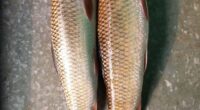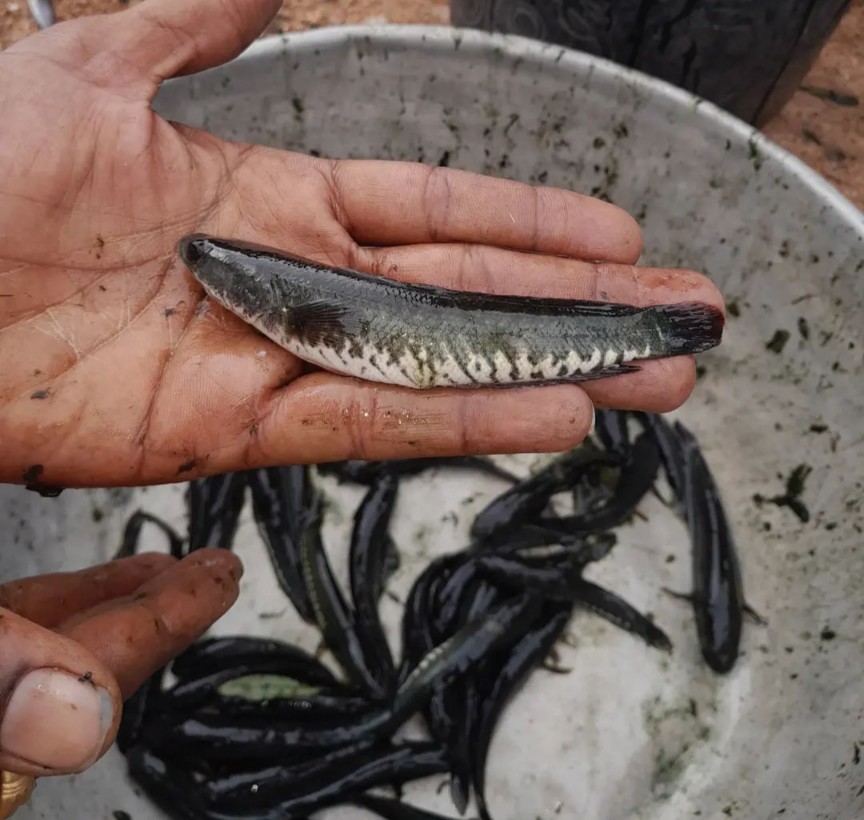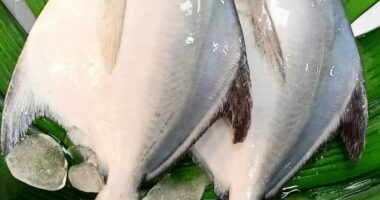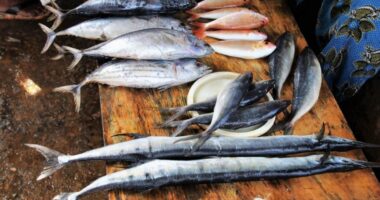Introduction to Murrel Fish Seeds
Murrel fish, scientifically known as Channa striata, holds immense promise in the aquaculture industry. Murrel fish seeds refer to the early developmental stages of these fish, including hatchlings, fry, and fingerlings. These seeds are the foundation of a successful mural fish farm, and understanding their cultivation is pivotal to a thriving aquaculture venture.
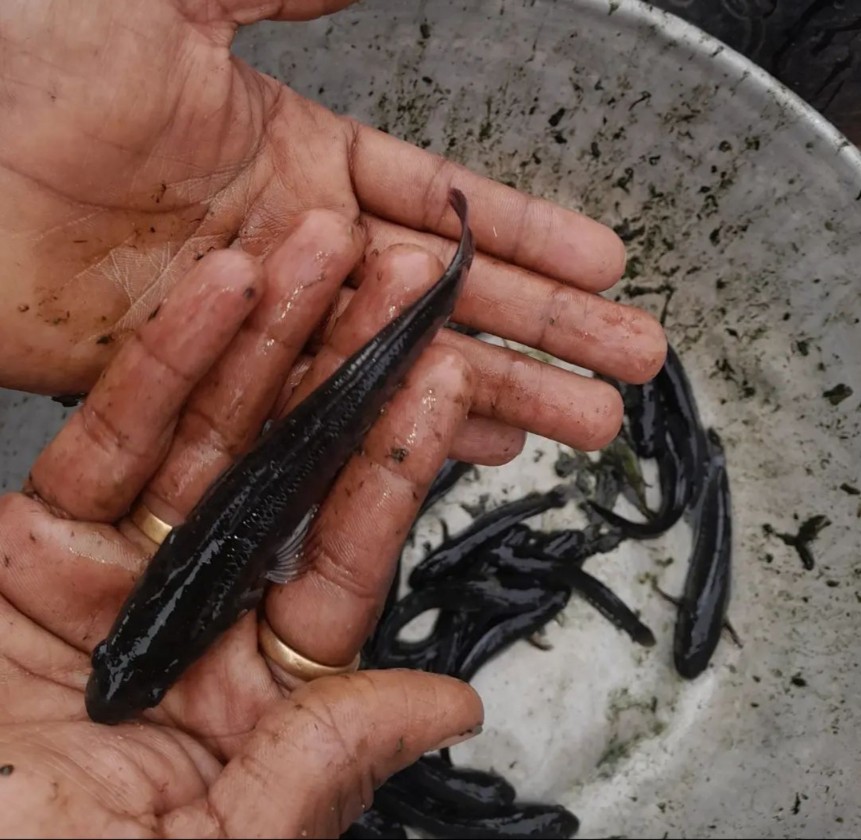
The Importance of Murrel Fish Seeds
Murrel fish are highly sought after for their delectable taste and nutritional value. They are also known for their hardy nature, making them relatively easier to cultivate compared to some other fish species. The demand for murrel fish in various culinary cuisines has fueled the interest in cultivating them, and this is where murrel fish seeds play a crucial role.
The Indian name for Murrel fish seeds is “Viral Meen Vithai.”
How to Grow Murrel Fish Seeds

- Choose the Right Location: Selecting the right location for your Murrel fish seeds cultivation is essential for their successful growth. Choose a pond that receives plenty of sunlight throughout the day. Adequate sunlight helps in promoting the growth of aquatic plants and algae, which serve as a natural food source for the fish. Additionally, ensure that the pond has a consistent and reliable source of water, as fluctuations in water levels can stress the fish. Consider the soil quality, depth, and size of the pond. The soil should be suitable for digging and retaining water. A pond with a depth of at least 1.5 meters is recommended for Murrel fish seeds farming, as it provides enough space for the fish to thrive.
- Prepare the Pond: Before introducing Murrel fish seeds to the pond, proper preparation is crucial. Start by clearing the pond of any unwanted vegetation, debris, or predators that could harm the fish. Remove aquatic weeds and create a clean environment for the fish to grow. Creating shelters in the pond is important, as it provides hiding spots for the fish and encourages natural behavior. You can use aquatic plants, rocks, or specially designed structures to create these shelters. These shelters not only reduce stress on the fish but also contribute to a healthier ecosystem within the pond.
- Source Quality Seeds: The success of your Murrel fish seed farming largely depends on the quality of the seeds you acquire. Purchase Murrel fish seeds from reputable hatcheries that specialize in producing high-quality seeds. Healthy seeds have a better chance of surviving and growing into robust fish. Reputable hatcheries follow proper breeding and rearing practices, which ensure that the seeds are disease-free and genetically strong. Before purchasing, inquire about the hatchery’s breeding techniques, health management practices, and seed transportation procedures to ensure you’re getting the best seeds for your farm.
- Transportation: Transporting Murrel fish seeds from the hatchery to your pond requires careful handling to minimize stress and ensure their well-being. During transportation, maintain the appropriate water temperature and oxygen levels. Use insulated containers to regulate the water temperature and prevent sudden temperature changes that could shock the fish. Adequate aeration is also crucial to provide the fish with enough oxygen during transit. Minimize the duration of transportation to reduce stress on the seeds. Upon arrival, gradually introduce the fish to the new pond environment by acclimatizing them to the water temperature and quality.
- Introduce the Seeds: When introducing Murrel fish seeds to the pond, take your time and avoid sudden changes. Gently release the seeds into the water, allowing them to swim and adjust at their own pace. Avoid overcrowding, as it can lead to stress and competition among the fish. Monitor their behavior closely during the initial hours to ensure they’re adapting well. Healthy fish will show active swimming patterns and exploration of the pond.
- Monitor Water Quality: Regularly monitoring water quality is paramount for the health and growth of Murrel fish seeds. Keep track of the water temperature, oxygen levels, pH balance, and ammonia levels. Fluctuations in these parameters can stress the fish and impact their growth. Invest in quality water testing kits to accurately measure these parameters. Maintain a clean pond by removing excess algae and debris. Proper water circulation and aeration are crucial for maintaining oxygen levels, especially in warmer months.
- Feeding Regimen: Feeding plays a crucial role in the growth and development of Murrel fish seeds. Provide a balanced diet that includes both live and formulated feeds. During the hatchling phase, feed them with freshly hatched brine shrimp or other suitable live feeds. As they grow into the fry and fingerling stages, gradually introduce formulated feeds that contain essential nutrients and proteins. Pay attention to the fish’s feeding behavior. If they consume the food within a few minutes and show active interest, you’re on the right track. Adjust the feeding frequency as they grow, taking care not to overfeed, which can lead to water pollution and health issues.
- Disease Prevention: Disease prevention is a critical aspect of Murrel fish seed farming. Preventive measures start with sourcing high-quality seeds from reputable hatcheries. However, even with healthy seeds, it’s important to implement disease prevention strategies. Quarantine new fish before introducing them to the main pond to ensure they are not carriers of diseases. Maintain good hygiene practices by regularly cleaning the pond and removing any dead or sick fish. If you notice any signs of disease, such as unusual behavior or changes in appearance, seek advice from aquaculture experts or veterinarians to diagnose and treat the issue promptly.
- Monitor Growth Stages: The growth stages of Murrel fish seeds are crucial points in their development. During the hatchling phase, which lasts for a few days, provide a suitable environment with consistent water quality and appropriate food sources. In the fry phase, when they start feeding more actively, monitor their growth rate and adjust the feeding regimen accordingly. As they progress to the fingerling stage, observe their size and behavior. Healthy fish will display vibrant colors, active swimming, and strong appetite. Adjust water quality parameters and feeding practices to support their growth throughout these stages.
- Harvesting: Harvesting Murrel fish is the culmination of your efforts and a key step in Murrel fish seed farming. Harvest them when they reach the desired size and weight. The ideal size for harvesting depends on the market demand and your farming goals. Signs of readiness include well-developed bodies, strong swimming patterns, and vibrant colors. Use a suitable net or harvesting equipment to gently catch the fish. Avoid stressing them during the process.
- Post-Harvest Handling: Proper post-harvest handling is essential to maintain the quality of the harvested fish. Place the fish in clean, aerated water to reduce stress. Keep them in a shaded area to avoid direct sunlight and temperature fluctuations. If you’re processing the fish for sale or consumption, do so promptly. Clean and gut the fish carefully, removing any scales and entrails. Properly stored and processed fish fetch better prices in the market and ensure customer satisfaction.
- Market Opportunities: Once you have successfully grown and harvested your Murrel fish seeds, it’s time to explore market opportunities. Establish connections with local markets, restaurants, and suppliers who are interested in sourcing fresh, locally grown fish. Highlight the unique taste and nutritional benefits of Murrel fish seeds to attract consumers. Consider participating in farmers’ markets or setting up a direct sales channel to connect with customers who appreciate fresh, sustainably grown seafood.
Remember that Murrel fish seed farming is a dynamic process that requires ongoing learning and adaptation. Stay informed about the latest advancements in aquaculture techniques and seek guidance from experienced farmers. By following these elaborated steps, you’ll be well-equipped to nurture Murrel fish seeds into healthy adults and contribute to a thriving aquaculture venture.
Growth Timeline of Murrel Fish Seeds
The growth of Murrel fish seeds is a dynamic process that spans several distinct phases, each marked by significant developmental changes. Understanding this growth timeline is crucial for successful aquaculture and achieving optimal outcomes.
- Hatchling Phase
The growth journey of Murrel fish seeds begins with the hatchling phase. This is the earliest stage, right after the fish eggs hatch. During this phase, the fish are extremely delicate and vulnerable. They rely on their yolk sacs for nourishment, and their main focus is developing their internal organs and basic body structures. Hatchlings are generally very small and require a controlled and stable environment. This phase typically lasts for about 7 to 10 days, but the duration can vary based on factors like temperature and water quality.
- Fry Phase
As the hatchlings transition into the fry phase, they become more active and start swimming and feeding. At this point, they begin to outgrow their yolk sacs and require external sources of nutrition. Proper feeding practices are crucial during this stage to ensure healthy growth. Fry are still quite small and vulnerable to environmental changes, so maintaining stable water conditions and providing suitable feeds are paramount. The fry phase generally spans from 3 to 4 weeks.
- Fingerling Phase
The fingerling phase is a significant step in the growth of Murrel fish seeds. By this stage, the fish have developed more advanced bodily structures and are becoming heartier and more adaptable. They’ve also gained the ability to consume a wider variety of feeds. The fingerling phase is marked by rapid growth, and the fish exhibit more robust swimming behaviors. This phase typically lasts for 4 to 6 weeks. The fish are now larger and more resilient, making them better equipped to handle minor changes in their environment.
- Factors Affecting Growth Time
The time it takes for Murrel fish seeds to progress through these growth phases is influenced by several factors:
- Temperature: Warmer water temperatures generally promote faster growth, as the metabolic rate of fish increases in higher temperatures.
- Feeding Practices: Providing a nutritious and well-balanced diet at each growth stage is crucial for steady and healthy development.
- Water Quality: Maintaining optimal water quality—covering factors like oxygen levels, pH balance, and ammonia concentration—is essential for unhindered growth.
- Health and Genetics: The overall health of the fish and their genetic makeup play a role in determining growth rates.
- Environmental Stability: Sudden fluctuations in water temperature or other environmental factors can stress the fish and affect growth.
- Managing Growth
To ensure successful growth of Murrel fish seeds, close monitoring and adaptive management are necessary. Regularly assess their development, behavior, and overall health. Adjust feeding practices based on their growth stage and feed consumption. Continuously maintain stable water conditions and promptly address any health concerns or disease outbreaks.
Remember that while the average timeline provides a rough guideline, individual fish may exhibit variations in growth rates. Providing optimal care and attention to the specific needs of Murrel fish seeds at each growth phase will contribute to their successful cultivation and the overall success of your aquaculture venture.
Best Food for Murrel Fish Seeds:


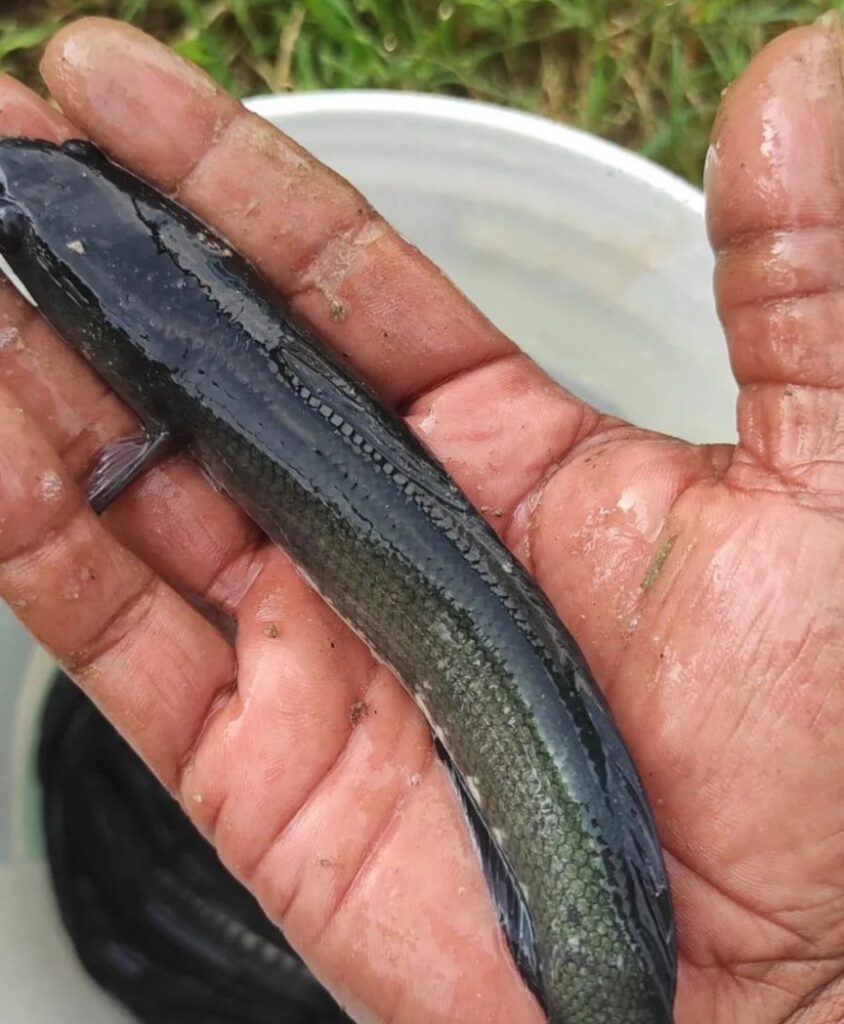
Just like any living organism, Murrel fish seeds require a balanced diet to thrive. Proper nutrition contributes to their growth, immune system strength, and overall vitality. The food they consume during these crucial stages sets the foundation for their future as robust and healthy fish.
- Natural Food Sources for Murrel Fish Seeds
- Zooplankton and Insects: Nature’s Bounty: In their natural habitat, Murrel fish seeds feast on a variety of zooplankton and insects. These small organisms are rich in proteins, essential fatty acids, and vitamins. Offering zooplankton such as Daphnia and copepods mimics their natural diet and provides valuable nutrients for healthy growth. Additionally, insects like mosquito larvae and small worms are excellent choices, as they offer a diverse nutritional profile.
- Small Fish and Crustaceans: Protein-Rich Delights: As Murrel fish seeds grow, their appetite for more substantial meals increases. Introducing small fish like guppies and minnows provides a protein-rich diet that supports rapid growth. Crustaceans such as brine shrimp and small crustaceans offer essential minerals and amino acids that contribute to their well-being.
- Formulated Feeds for Optimal Growth
- Understanding Nutritional Requirements: Formulated feeds are specially designed to meet the nutritional needs of Murrel fish seeds. These feeds are available in various pellet sizes and compositions, catering to different growth stages. They are carefully formulated to provide a balanced combination of proteins, carbohydrates, fats, vitamins, and minerals.
- Evaluating Commercial Feeds: When choosing commercial feeds, opt for reputable brands known for their quality. Look for feeds that specify the targeted growth stage of the fish. Read the nutritional information to ensure that the feed meets the dietary requirements of Murrel fish seeds. Pay attention to the protein content, as it’s a key component for their growth.
- Feeding Techniques for Murrel Fish Seeds
- Frequency and Portion Control: Feeding Murrel fish seeds is not just about providing the right food; it’s also about proper feeding techniques. Offer feeds multiple times a day, as these growing fish have high metabolic rates. However, avoid overfeeding, which can lead to water pollution and health issues. Portion control is vital, and it’s better to offer small, frequent meals rather than large portions.
- Ensuring Efficient Feed Consumption: Monitor the feeding behavior of Murrel fish seeds to ensure they are consuming the provided feeds. If the food remains uneaten after a few minutes, you might be offering too much. Adjust the portion size accordingly. Observe their response to different types of feeds and make note of their preferences.
- Monitoring Growth and Adjusting Feeding
- Observing Growth Patterns:
- Regularly monitor the growth of Murrel fish seeds to gauge the effectiveness of their feeding regimen. Healthy and well-fed fish will exhibit steady growth, vibrant colors, and active behavior. Keep records of their growth milestones to track their progress accurately.
- Adapting Feeding Strategies: As Murrel fish seeds progress through different growth stages, their nutritional needs evolve. Adjust the composition and size of the feeds accordingly. For example, during the fry phase, focus on smaller feeds rich in protein, while fingerlings might benefit from slightly larger pellets with a balanced nutritional profile.
Feeding Murrel fish seeds is a responsibility that directly influences their growth trajectory. By offering a diverse and balanced diet that includes natural food sources and formulated feeds, you’re setting the stage for healthy, vibrant, and thriving fish. Whether you’re a seasoned aquaculturist or a beginner in fish farming, understanding the significance of proper nutrition is key to your success.
Maintaining Optimal Water Quality for Murrel Fish Seeds
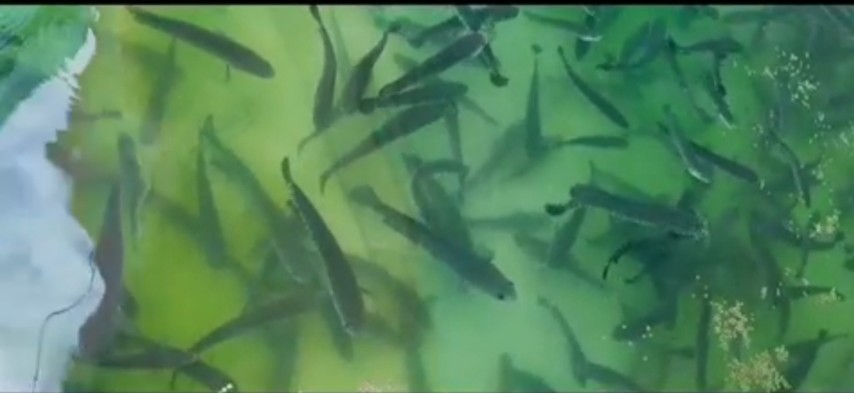
Water quality plays a multifaceted role in the growth and well-being of Murrel fish seeds. Clean and well-maintained water provides essential nutrients, supports respiration, and prevents stress-related health issues. It’s not just the quantity of water that matters; its quality profoundly influences the aquatic ecosystem within which these seeds thrive.
- Key Parameters for Ideal Water Conditions
- Temperature: The Goldilocks Zone: Maintaining the right water temperature is crucial for the overall health and growth of Murrel fish seeds. The optimal temperature range typically falls between 25°C to 30°C (77°F to 86°F). This range promotes metabolic processes, digestion, and immune system function. Sudden temperature fluctuations can stress the fish and lead to various health issues.
- Oxygen Levels: Lifesaving Gas Exchange: Adequate oxygen levels are vital for the survival of Murrel fish seeds. Oxygen is obtained through gas exchange at the water’s surface. Proper aeration, water movement, and sufficient plant growth contribute to maintaining optimal oxygen concentrations. Inadequate oxygen levels can lead to lethargy, reduced growth, and even mortality.
- pH Balance: A Delicate Equilibrium: Maintaining a stable pH level is essential for Murrel fish seeds to thrive. The recommended pH range is typically between 6.5 to 7.5. Fluctuations outside this range can stress the fish and impact their ability to absorb nutrients and minerals. Regular monitoring and proper buffering prevent pH swings.
- Ammonia and Nitrite Levels: Detoxification Matters: Ammonia and nitrite are toxic compounds that can accumulate in the water due to fish waste and decaying organic matter. High levels of ammonia and nitrite can be lethal to Murrel fish seeds. Implementing efficient filtration, regular water exchanges, and establishing beneficial bacteria colonies help detoxify these harmful substances.
- Monitoring and Maintaining Water Quality
- Regular Testing: The Foundation: Regular water quality testing is the cornerstone of effective management. Invest in reliable testing kits to monitor temperature, oxygen levels, pH, ammonia, and nitrite concentrations. Frequent testing allows you to identify changes in water parameters promptly and take corrective actions.
- Water Exchange and Aeration: Refreshing the Habitat: Performing partial water exchanges helps maintain water quality by diluting accumulated pollutants and replenishing essential minerals. Aeration, through air stones or water movement, enhances oxygen exchange and prevents stagnation. Together, these practices create a healthier habitat for Murrel fish seeds.
Neglecting water quality can have dire consequences for Murrel fish seeds. High ammonia and nitrite levels lead to ammonia poisoning, causing stress, respiratory distress, and even death. Poor oxygen levels suffocate the fish, stunting growth and compromising their immune systems. Drastic pH fluctuations induce stress and hinder nutrient absorption.
Maintaining optimal water quality is non-negotiable when it comes to cultivating Murrel fish seeds successfully. By meticulously managing temperature, oxygen levels, pH, and detoxifying harmful compounds, you provide a thriving environment for their growth and development. Your commitment to water quality translates into vigorous, vibrant, and resilient fish.
Disease Prevention and Health Management

Disease outbreaks can have devastating consequences for Murrel fish seeds. They can lead to stunted growth, mortality, and economic losses. Preventing diseases is not only more effective but also more cost-efficient than treating them after they occur. By focusing on proactive measures, you create a resilient environment for your fish to flourish.
- Biosecurity: The First Line of Defense
- Quarantine Procedures for New Fish: When introducing new fish to your pond, implementing quarantine procedures is crucial. Isolate the newcomers for a period to observe their health and behavior. This prevents potential disease transmission to your existing stock. Monitor them closely for any signs of illness before introducing them to the main pond.
- Hygiene and Equipment Maintenance: Maintain strict hygiene standards in your aquaculture operation. Clean and disinfect equipment, nets, and tanks regularly to prevent the spread of pathogens. Avoid using equipment that has been in contact with other water bodies to minimize the risk of introducing diseases.
- Quality Water and Environment
- Optimal Water Quality Parameters: Maintaining optimal water quality is paramount for disease prevention. As discussed previously, ensure appropriate temperature, dissolved oxygen levels, pH balance, and minimal ammonia and nitrite levels. Regular water testing and necessary adjustments are essential.
- Habitat Management and Cleaning: Regularly clean the pond and remove debris to prevent the buildup of pathogens. Implement proper waste management and filtration systems to keep the environment clean and conducive to fish health. Provide proper aeration to avoid stagnant water areas.
- Balanced Nutrition: A Foundation for Health
- Feeding Practices and Nutritional Balance:Offer a balanced diet that meets the nutritional needs of Murrel fish seeds. Provide a mix of natural food sources and formulated feeds that are rich in essential nutrients. A well-balanced diet contributes to robust immune systems and overall health.
- Avoiding Overfeeding: Overfeeding can lead to excess waste in the water, negatively impacting water quality and potentially causing stress to the fish. Feed Murrel fish seeds multiple times a day but in controlled portions to avoid wastage.
- Stress Reduction Techniques
- Minimizing Handling Stress: Minimize handling and disturbances to Murrel fish seeds. Excessive handling can stress the fish and make them more susceptible to diseases. When necessary, handle them gently and avoid sudden movements.
- Providing Hiding Places: Create hiding spots and shelters within the pond. These hiding places provide Murrel fish seeds with refuge from potential stressors such as predators or unfavorable environmental conditions.
- Monitoring and Early Detection
- Regular Health Checks: Conduct regular health checks to assess the overall condition of Murrel fish seeds. Observe their behavior, growth rate, and appetite. Any deviations from the norm could indicate a health issue.
- Identifying Symptoms and Behavior Changes: Be vigilant in observing any unusual symptoms or changes in behavior. Common signs of illness include lethargy, loss of appetite, abnormal swimming patterns, and discoloration. Early detection can lead to timely intervention.
- Treatment Protocols
- Consulting Aquaculture Experts: In the event of disease outbreaks or health concerns, consult aquaculture experts or veterinarians. They can provide accurate diagnoses and recommend appropriate treatments.
- Safe and Effective Treatment Options: If treatment is required, opt for safe and effective methods. Medications, herbal remedies, and probiotics are some options to consider. Follow treatment protocols carefully to avoid further stress to the fish.
Ensuring the health of Murrel fish seeds involves continuous vigilance and dedicated care. By implementing biosecurity measures, maintaining optimal water quality, providing balanced nutrition, and monitoring their well-being, you’re setting
Harvesting and Marketing Murrel Fish seeds

Harvesting marks the fruition of your labor and signifies the transition of Murrel fish seeds from their early stages to the next chapter of growth. Effective marketing, on the other hand, ensures that your seeds reach the right customers and markets, creating a sustainable revenue stream and establishing your presence in the aquaculture industry.
- Harvesting Techniques for Murrel Fish Seeds
- Selecting the Right Time: Timing is of the essence when it comes to harvesting Murrel fish seeds. Generally, the ideal time for harvesting is when the fish have reached the fingerling stage, measuring around 3 to 4 inches in length. At this stage, they are more resilient, making the harvesting process smoother.
- Efficient Harvesting Methods: Harvesting methods vary based on the scale of your operation. For smaller ventures, using handheld nets or dip nets can be effective. Larger operations might opt for seine nets or specially designed harvesting equipment. Handle the fish with care to avoid stress and injury.
- Post-Harvest Handling and Transportation
- Minimizing Stress and Injury: After harvesting, minimize stress to Murrel fish seeds during handling. Keep them in water-filled containers with adequate aeration. Avoid overcrowding, which can lead to stress and injury. Gradually acclimate them to changes in water temperature and quality.
- Water Management during Transportation: If you need to transport murrel fish seeds, ensure proper water management. Use oxygenated water and keep the transport containers stable to prevent excessive movement. Minimize travel time to reduce stress.
- Quality Control and Grading
- Ensuring Seed Health and Size: Conduct thorough quality checks before packaging and marketing. Remove any weak or unhealthy fish seeds. Select seeds that are uniform in size and exhibit vibrant colors, indicating good health.
- Grading for Market Segmentation: Consider grading murrel fish seeds based on size for different market segments. This allows you to cater to various customer preferences and demands. Clearly label the grade of the seeds for transparency.
- Packaging and Presentation
- Optimal Packaging Materials: Choose packaging materials that ensure the safety and well-being of Murrel fish seeds during transit. Use breathable bags or containers with secure closures to prevent water leakage.
- Labels and Information: Include essential information on the packaging, such as the species, grade, quantity, and handling instructions. Clear labeling enhances customer trust and facilitates proper handling.
- Identifying Market Opportunities
- Local Demand and Beyond: Begin by tapping into local markets and understanding the demand for Murrel fish seeds. Explore nearby fish farms, hatcheries, and aquaculture enthusiasts who might be interested in purchasing your seeds. Gradually expand to regional and national markets.
- Establishing Distribution Channels:Collaborate with local fish stores, aquaculture supply shops, and online platforms to establish distribution channels. Participate in aquaculture exhibitions and events to showcase your seeds and network with potential buyers.
- Marketing Strategies for Success
- Building a Brand Identity: Develop a brand identity that reflects the quality and uniqueness of your Murrel fish seeds. Create a memorable logo, packaging design, and a compelling brand story that resonates with customers.
- Online and Offline Promotion: Leverage the power of both online and offline promotion. Create a user-friendly website or social media profiles to showcase your products. Share educational content, success stories, and testimonials to engage your audience.
The journey from cultivating Murrel fish seeds to harvesting and marketing them is a testament to your dedication and expertise. By mastering the art of timing, ensuring seed quality, and implementing effective marketing strategies, you’re not only reaping the rewards of your hard work but also contributing to the growth of the aquaculture industry.
Tips for Successful Murrel Fish Seeds Farming
Seek guidance from experienced murrel fish farmers. Their insights can provide valuable lessons and shortcuts to success. Stay updated on the latest advancements in aquaculture techniques.
Conclusion
Embarking on the journey of murrel fish seeds cultivation requires dedication and knowledge. By understanding their growth stages, providing proper nutrition, and implementing disease prevention strategies, you can ensure a prosperous aquaculture venture. Remember, every step you take contributes to the thriving ecosystem you build.
FAQs
What is the best water temperature for murrel fish seeds cultivation?
The optimal water temperature ranges between 25°C to 30°C.
Can I cultivate murrel fish seeds in a backyard pond?
Yes, as long as the pond meets their environmental requirements.
How often should I feed murrel fish seeds?
Feed them 3 to 4 times a day, adjusting quantities as they grow.
What are some common diseases that affect murrel fish seeds?
Common diseases include bacterial infections and parasitic infestations.
Where can I find high-quality murrel fish seeds?
Reputable hatcheries and aquaculture suppliers are your best options.
